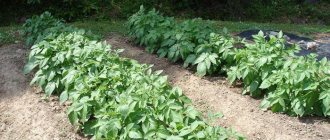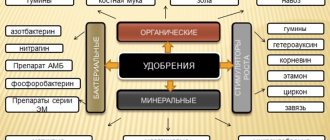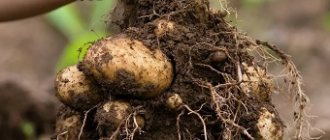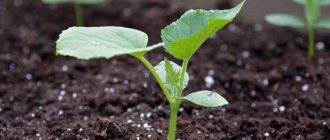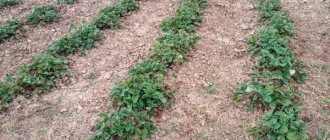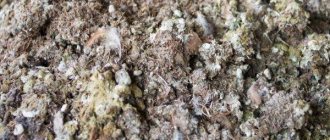Today there are a huge number of effective and good fertilizers that help to significantly increase potato yields, improve their appearance and accelerate growth. Among such a wide choice, it is not always possible to find the best remedy after testing popular drugs in action. Below we consider only the best fertilizers among popular varieties.
Why do you need to fertilize potatoes?
Most gardeners are accustomed to the fact that crops cannot be grown without fertilizers. Potatoes consume nutrients very intensively due to a weakened root system and large tubers. In the autumn, when harvesting, most of the useful fertilizers are removed from the soil. Due to this, it is very important to make up for losses during planting in the new season. Otherwise, the harvest will be smaller and smaller every year.
A few weeks before planting potatoes, it is advisable to sow green manure (plants that improve the composition and structure of the soil).
Expert secrets for increasing your harvest
- The Dutch planting method saves up to 25% of the harvest even in small areas. The scheme is simple - the distance between holes in a row is 20-25 cm. The distance between rows is at least 80 cm. When loosening, wide paths protect the integrity of the root space (this zone is not trampled).
- Radishes are sown along one edge of the row with tubers, and peas on the other . Radishes, like all Cruciferous green manures, disinfect the soil, and peas enhance the productivity of potatoes.
- You can hill up young bushes only in the early morning or late evening . Hot, heated soil under the sun injures green shoots. The tops will turn yellow and stop growing. Green stems can withstand temperatures up to 45-50 C. Moreover, sprouts need to be spudded once when they grow to 12-15 cm. Next, you just need to loosen the soil.
Organic fertilizers
Many years ago, our ancestors used organic fertilizers when growing potatoes. There are many undeniable advantages to using organic matter:
- Organic fertilizers are excellent for all types of soil and have a beneficial effect on microorganisms that enrich the soil with humus. Organic matter gradually releases nutrients, due to which the soil is not oversaturated with nutrients.
- Organic fertilizers contain many microelements - this helps to obtain balanced nutrition, which the crop needs.
- Organic matter heals the soil as quickly as possible. Next, the gardener only needs to maintain its condition without making much effort.
- Such fertilizers are absolutely safe and useful for any crops.
- The use of organic fertilizers provides potatoes with additional substances that strengthen the plant’s immune system, helping to resist diseases.
- Feeding is good because it prevents the plant from growing excessively and uncontrollably.
But organic fertilizers also have several disadvantages that need to be taken into account:
- In some regions it is very difficult to obtain organic fertilizers. For this reason, their cost is much higher than the price of mineral fertilizers.
- Organics will only work if the soil contains microorganisms that can break down organic matter into useful elements.
- During the cold season, organic fertilizers do not release nutrients into the soil.
The best organic fertilizers are:
- Ash. It contains many useful components: phosphorus, potassium, calcium and other trace elements. This fertilizing helps to significantly reduce the acidity of the soil, which is especially important for potatoes, because soil with a high acidity level is not suitable for them.
- Compost. Has beneficial properties. Available for self-cooking based on plant residues. If you add peat to the compost heap, the beneficial properties of the fertilizer will increase.
- Manure. This fertilizer consists of excrement from agricultural animals. Horse and cow manure and chicken manure are most often used. Manure is rich in nitrogen, potassium, calcium and phosphorus. It is considered one of the best fertilizers for potatoes.
What kind of soil do potatoes like?
Potatoes prefer loose, fertile and light soil with a slightly acidic reaction. It needs to be planted in illuminated areas, protected from the north wind. Lowland and wetlands are not suitable for growing tubers.
ATTENTION! When choosing a place for potatoes, it is worth considering the rules of crop rotation. Thus, a crop cannot be grown in one place for 2 years in a row. And areas where tomatoes, eggplants, and peppers previously grew are not suitable for her. The best predecessors are cabbage, beets, cucumbers or carrots.
To get a rich crop harvest, the planting area should be prepared in advance, in the fall. To do this you need to follow simple instructions:
- Dig up the soil in the area to a depth of a spade.
- Remove plant debris and weeds.
- Scatter manure cakes over the surface of the area and sprinkle them with soil or sand.
IMPORTANT! You can use fresh organic matter only during autumn preparation. If the soil is fertilized in the spring, then rotted manure must be used. For every sq. m area you need to add 8-10 kg of organic matter.
- Additionally add mineral complexes. For every sq. m should add 12 g of nitrate, 25 g of potassium sulfate and 50 g of double superphosphate.
- In spring, thoroughly loosen the soil to a depth of 10-12 cm. If the soil is dense and clayey, then repeat the procedure before planting the crop.
- Level the area with a rake.
Organomineral
Such fertilizers include organic substances and mineral compounds combined with them. Such fertilizers are considered the most effective, due to the fact that they contain all the necessary elements to nourish plants and soil. Organomineral supplements help increase fertility and productivity. Their price is quite affordable, gardeners widely use them. Organomineral fertilizers include liquid, humic and complex additives. The best of them are discussed below.
Joy fertilizer “Seedlings”
A fertilizer containing potassium in large quantities - used to feed potatoes and other crops. Suitable for use both in the standard way and for soaking seeds. This fertilizer provides excellent nutrition and accelerates seed germination several times in the future. The composition also contains nitrogen, sulfur, magnesium, phosphorus, silicon, molybdenum, etc. Humic substances also contain salts - their share is 2.7%. Before use, the product is diluted with water.
The supplement is sold in liquid form in a 330 ml bottle. Gardeners note that the use of Joy Lignohumate “Seedlings” effectively accelerates the growth of seed germination and promotes good plant development. Fertilizer improves the quality of seeds and accelerates their growth. Fertilizer increases productivity, while its consumption is minimal. The average cost of fertilizer is 140-160 rubles.
Fertika organo-mineral mixture
The fertilizer consists of 18% humate and contains many useful microelements necessary for proper nutrition of plants. Fertika fertilizer is sold in granules, each of which contains a full range of substances that ensure active potato growth.
The additive is used as the main application - 10-15 g are added to each well; during watering, about 30 g are consumed per 1 liter of water. For feeding several times a season, 20-40 g are needed per 1 square meter. In the southern regions, fertilizer is used in February, in the middle zone - from early spring.
The gardener can choose a package weighing 900 g or 2.5 kg. The fertilizer is created for open and protected soil. According to reviews, one small package is enough to fertilize 40 square meters of area. Fertilizer instantly affects the root system and soil.
The advantages include intensive stimulation of plant growth, improved soil quality, minimal waste, efficiency and high-quality nutrition. The average cost of fertilizer is 290-300 rubles.
Gumi-Omi
Organomineral fertilizer was developed specifically for potatoes. It is also used for carrots and radishes. The substance helps increase productivity, nourishes plant roots, saturating them with useful elements, stimulating active growth. With its help, the quality of the soil is significantly improved.
Gumi-Omi has protective functions. The main component is chicken manure, which goes well with beneficial microelements: boron, copper and gumi. One package contains 700 grams of the additive - it is enough to fertilize 10 square meters.
Fertilizer is used in the spring before planting, placing 20-40 grams in each hole. It also serves as a top dressing once every two weeks before the bulbs begin to set. The fertilizer has a shelf life of 4 years.
The main advantages include the following:
- has a natural composition;
- suitable for universal use;
- gardeners speak positively about it;
- ideal for potatoes;
- has a low cost - 60-80 rubles.
Buoy fertilizers OMU "Potato"
Mineral fertilizer is one of the best for feeding potatoes. It contains phosphorus in a concentration of 6%, magnesium 6%, nitrogen 10%, potassium 16%. It is important that it does not contain chlorine harmful to plants. Sold in granule form. Distributed in small quantities. When planting, 10 grams of fertilizer are consumed per hole, before hilling - 20 grams, when preparing the soil - 50 grams are consumed per 1 square meter.
The shelf life of the supplement is 5 years. Organomineral fertilizer helps improve plant metabolism and reduce the risk of infection with various diseases. The additive protects the crop from the negative effects of the environment. One package contains 3 or 5 kilograms of substance. Due to slow consumption, money is saved on the purchase of new packages.
Fertilizer has the following advantages:
- high efficiency;
- lack of chlorine in the composition;
- high content of useful elements;
- positive reviews from gardeners;
- convenient use;
- slow consumption;
- acceleration of plant growth and development.
The average cost of fertilizer is 320-350 rubles, which is considered inexpensive if it has good weight in the package.
How to calculate the required amount of fertilizing?
The chemical composition of the soil affects the required amount of fertilizer for tubers. Potatoes love slightly acidic soils. Ideal for it is from 5.5 to 6.5 pH. For each personal plot it is necessary to individually calculate the norm.
Knowing the level of soil fertility, it is advisable to use the following fertilizer options per 1 acre:
Find out also
What to do if potatoes have large tops
for fertile soil, take and mix the following ingredients in the indicated dosages:
- humus - 2 kg;
- superphosphate - 2-2.5 kg;
- potassium fertilizing - 1-1.5 kg;
for medium-fertile soil it is necessary to use the following fillers:
- humus or compost - 2.5-3 kg;
- nitrogen fertilizing - 3 kg;
- phosphorus fertilizers - 3 kg;
- potassium fertilizing - 2.5 kg.
Depleted soil needs 1 kg of ammonium nitrate, 3 kg of superphosphate and 100 kg of humus.
Mineral
This group of fertilizers has a good composition - mineral additives include useful minerals such as nitrogen, potassium, phosphorus, copper, zinc and others.
Mineral supplements can contain one mineral - simple, or several minerals at once - complex. They are easy to transport due to their compact design. Mineral fertilizers are used depending on the type of soil, mainly in the spring when sowing.
Folirus Bor
The fertilizer is intended for foliar feeding of plants. This is a liquid substance added to the soil when there is a lack of boron. It is considered one of the best fertilizers for potatoes, because it actively fights slow growth, helps accelerate fruit formation, and strengthens internodes. Research by VNIIK has proven that the use of this fertilizer has an excellent effect on potato yields, increasing the rate from 3 to 13%.
In a specialized store, a gardener can purchase Folirus Bor in a canister with a volume of 1 to 20 liters.
If there is a lack of boron, serious consequences cannot be ruled out: buds may die, flowering and bushiness will slow down, and flowers will begin to fall off. With the help of this fertilizer all these problems are solved. Experts recommend using it both in case of severe boron deficiency and in combination with other useful supplements.
The advantages of Folirus Boron include high concentration of the element, efficiency, and affordable cost - about 350-400 rubles.
Bona Forte fertilizer for potatoes and root crops
This fertilizer is considered one of the best, due to the fact that it has a particularly useful composition. The drug includes the following components:
- potassium;
- phosphorus;
- molybdenum;
- nitrogen;
- manganese;
- magnesium;
- titanium;
- boron;
- bioavailable silicon.
The additive actively reduces nitrates in fruits. The fertilizer is intended for use at all stages of sowing, both during soil preparation and when planting potatoes. To feed potatoes before flowering, use 1-2 times with an interval of one and a half to two weeks. About 2-3 grams of the additive are consumed per plant during planting. On average, one package is enough to fertilize three acres.
Bona Forte improves the soil structure, helps reduce nitrate content, increase germination and increase the freshness of the crop, protect plants from negative influences, and accelerate their growth.
Most of the components included in the fertilizer are necessary for the full development of plants. Fertilizer is produced in bags weighing 2.5 or 5 kilograms. The average cost is 350 rubles.
"Fertika" Potato-5
This is one of the most popular mineral potato fertilizers. It is produced in the form of granules containing a complex of useful elements, including magnesium, sulfur and others. An important feature is the absence of chlorine. The fertilizer is intended for feeding in the spring during the planting period and in the summer during the growing season. In a specialized store they offer packages weighing 2.5 and 5 kilograms. A small package is enough for several seasons, depending on the area planted. After using Fertika, the growth of tubers is significantly accelerated and their quality improves.
There are several options for using fertilizer:
- When planting potatoes in holes, distribute 15-20 g of fertilizer per plant or cover the soil during the growing season - 30-40 g of the substance is consumed per bush.
- In early spring, scatter fertilizer over the area - 70 g of Fertika is used per 1 square meter. This is required to properly prepare the soil and saturate it with useful elements.
The main advantages of the fertilizer are its low cost - about 350 rubles, high quality, efficiency, low consumption, useful elements in the composition.
Autumn and spring application
The land for potatoes begins to be prepared in the fall. This saves valuable time at the beginning of the season, gives the soil a chance to rest, manure to decompose, and granular complexes to dissolve.
For plowing (digging), half or completely rotted manure and full-fledged humus (from 200 to 400 kg per hundred square meters) are added to poor soils every 3-5 years. At the same time, cow and horse manure is preferable to pig manure . Complex mineral mixtures are also added, for example, superphosphate (1 tablespoon per 1 m2) + potassium sulfate (1 teaspoon). Often, gardeners limit themselves to “dressing” the soil in the fall, and in the summer they only carry out watering and foliar feeding.
If it was not possible to prepare the site in the fall, then in the spring when planting potatoes, fertilizers are not applied randomly, but placed in each hole or furrow
Complex fertilizers
Complex fertilizers contain two or three essential nutrients, some are also supplemented with microelements. This is both a plus and a minus, because, despite the fact that there is no need to purchase several different packages and mix the required amount from each, the percentage of different elements may not correspond to the needs of the potatoes. It is known that nitrogen is applied in the spring, and potassium and phosphorus in the fall. Because of this, phosphorus-potassium fertilizers have been developed and are being sold today, presented in the table below:
| Name | Phosphorus content | Potassium content | Other elements |
| Agrofoska | 15% | 4% | magnesium 3%, calcium 25% |
| Potassium monophosphate | 52% | 34% | |
| Ecoplant | 6% | 35% | sulfur 1%, magnesium 9%, calcium 13% |
| Autumn | 5% | 18% | boron 0.2%, magnesium 2.5%, calcium 8% |
In addition to the application season, the peculiarity of phosphorus-potassium fertilizers lies in the depth of placement. Potassium and phosphorus contribute to the formation of strong compounds with substances in the soil, remain where they were added, do not disappear into the air like nitrogen, and do not evaporate deeper into rainwater. If you scatter fertilizers on the surface, there will be no result. Complex fertilizers are applied directly to the root zone when digging or placed at the bottom of the hole when planting.
The table below shows nitrogen fertilizers:
| Name | Nitrogen content | Phosphorus content | Potassium content |
| Nitroammofoska | 17% | 17% | 17% |
| Nitrophoska | 11% | 10% | 11% |
| Nitrophos | 23% | 17% | — |
| Diammofos | 18% | 46% | — |
| Ammophos | 9-12% | 42-52% | — |
Nitroammofoska is considered the best of the complex fertilizers containing nitrogen, due to the fact that it has a balanced composition. The rest need some changes, that is, the additional introduction of some element. For example, Diammophos and Ammophos contain 3-4 times more phosphorus than nitrogen, although potatoes require equal proportions of these elements. These fertilizers contain no potassium at all.
It is especially convenient to use fertilizers designed specifically for potatoes. They simultaneously contain organic and mineral substances, as well as microelements. The best fertilizers include Fertika, Gumi-Omi, Siberian Bogatyr and others. The only disadvantage is the high consumption, which affects the total cost of the fertilizer - 7-8 kilograms per hundred square meters.
Answers to frequently asked questions
Gardeners often have the following questions related to fertilizing potatoes:
Is it possible to combine fertilizers with each other?
Yes, and even necessary. Some fertilizers contain only phosphorus, others contain potassium and nitrogen. And in order for the crops to receive all the necessary elements, fertilizing should be combined.
How to combine organic and mineral fertilizers?
For example, you can combine compost with superphosphate and potassium sulfate. Wood ash and nitrophoska also go well together.
Do I need to water the hole before planting potatoes?
Yes. Most mineral and complex fertilizers are water-soluble and work only in moist soil.
Root feeding
Root fertilizers are applied after light loosening and before hilling the bushes. This way they reach the roots of the plants much faster, especially if the plants are well watered after application. For root feeding, the following substances are considered more effective:
- Bird droppings. This is a very aggressive fertilizer, but sometimes it is used even fresh, diluted with water in a ratio of 1:10. Fertilizer is applied to the trenches between the crop rows.
- Mullein infusion. Dilute 1 liter of fresh mullein in 10 liters of water and infuse it for several days. The rows between the plants are watered with fertilizer.
- Urea. Under one bush, add 500 ml of a composition prepared from 10 liters of water, 20 g of urea are diluted in it. The bushes are watered at the root after light loosening.
- Mineral fertilizers. These include various agrochemicals, for example, a solution of ammonium nitrate - 20 g per 10 liters of water. Occasionally, a mixture of potassium, phosphorus and nitrogen fertilizers is used in a ratio of 2: 1: 1 (25 g per 10 liters of water). 500-1000 ml of solution is poured under one bush.
What is better as a fertilizer for potatoes: urea or ammonium nitrate? Read the details here.
Experienced gardeners recommend using complex fertilizers that do not contain chlorine for early potatoes.
Possible mistakes in using fertilizers
Let us list the main mistakes that occur when adding organic matter and mineral complexes:
- Dosage violation . Those who use fertilizing according to the principle “the more, the better” are mistaken. Excess minerals instead of the desired yield can lead to disease and even death of plants. Nitrogen is especially dangerous in this regard. It looks like the mighty shoots with dark green foliage are just great! However, what follows is a lengthening of the growing season. Potatoes bloom later, form tubers less often and do not have the strength to grow them to a standard size. All the energy was spent on the growth of green shoots. Once in the soil, fertilizers are dissolved by water and converted into salt solutions. For proper nutrition, plants need a balance of internal and external salt concentrations. The saturation of plant tissues with salts stimulates the absorption of water by the roots. At the same concentration, the flow of moisture from the soil stops. Saltier soil draws sap from the stems, which leads to the death of the plantings. The consequences of such poisoning can be corrected by generously watering the soil, of course, if you are careful and notice the disorder in time.
- Applying fresh manure . The result will be excess nitrogen and its associated consequences. In addition, fresh manure is the basis for the development of pest larvae, the appearance of late blight, scab and other diseases. Half-rotted manure is applied only in the fall, so that it has time to completely decompose over the winter.
- Using dry mullein and chicken manure . They need to be dissolved in water in a ratio of 1:20 and watered 0.5 liters per 1 tuber or reduce the volume of organic matter as much as possible so as not to burn future plantings after rain or the first watering.
- Application of pure nitrogen fertilizers . The necessary element is added only in combination with other minerals. Otherwise, the tubers will turn out tasteless, watery, with voids inside.
- Abuse of humates . Salts of humic acids can be used on poor or depleted soils at the rate of 2 tbsp. l. per 10-liter bucket of water, 500 ml per well. Must be combined with potassium and phosphorus supplements. Then they turn from a growth stimulator into feeding.
Exceeding the norm of nitrates in root crops is one of the consequences of applying fertilizers and pesticides “by eye”
Foliar feeding of potatoes
Plants need feeding throughout the growing season. The first time it is very important to apply fertilizer after weeding the potatoes. This is done in the evening to eliminate the possibility of burning the leaves. Occasionally, fertilizing is applied in the morning, when the sun has not yet risen.
There are the following types of foliar feeding:
- Nettle infusion. The stems and leaves of nettle contain many substances necessary for potatoes: iron, potassium, nitrogen, calcium. Preparing the infusion is easy: chop 1 kg of nettle, pour in 3 liters of water. The composition is left for a day, filtered, after which 30 g of laundry soap is added to it. Start spraying.
- Phosphoric. It is carried out after the end of flowering, about a month before harvest, using superphosphate. To do this, dilute 100 g of the substance in 10 liters of water - this will be enough for 10 square meters.
- Urea. The composition is prepared as follows: 100 g of urea, 150 g of potassium monophosphate, 5 g of boric acid are diluted in 5 liters of water. If desired, it is permissible to add boron, zinc, copper, manganese or cobalt at the rate of 1 g per 10 liters. The first spraying is carried out 2 weeks after germination. After another 14 days, the treatment is repeated. The following fertilizing is applied every two weeks until the potatoes begin to bloom.
If you manage to feed the potatoes correctly, you will ensure high yields and obtain fruits with excellent taste and marketable appearance.
“Force”: application into the hole when planting potatoes
"Force" is a granular insecticide for protection against wireworms and other common pests. Designed for industrial use. However, it is successfully used on personal plots. Before planting potatoes, the drug or its analogues can be placed in the hole at a rate of 15 g per plant. The granules are thoroughly mixed with the ground so that, if possible, they do not come into contact with mineral fertilizers and tubers. For a month and a half, the future harvest will be under guaranteed protection from damage. This is a good solution for large areas.
Pre-planting soil disinfection with special preparations also eliminates the pest problem
Fertilizer application is an important and responsible matter, causing controversy, approval and protests. One thing is clear: the issue is worth studying if you strive to obtain high yields with maximum benefits and excellent taste of tubers.
Growth stimulants
Mineral fertilizers contribute to the nutrition of potatoes - their compositions include elements that act as building materials for the future harvest. There are also growth stimulants that increase resistance to diseases and adverse conditions and accelerate metabolic processes. They have the same effect on potatoes as vitamins have on humans. When treated with growth stimulants, productivity increases by 10-30%. There are several of the best stimulants for potatoes.
Epin
It has a pronounced anti-stress effect - it helps potatoes withstand sudden temperature changes, drought, and prolonged cloudy weather; increases resistance to diseases. Increasing yield results in tubers growing faster. Increases yield by 15-30%.
Epin is intended for treating seed tubers several hours before planting. 1 ml of stimulant is consumed for 1 glass of water - this is enough to process 50 kg of potatoes. The procedure is also carried out at the beginning of flowering - 1 ml of Epin is used for 5 liters of water. If plants suffer from frost, drought or lack of sunlight, they are sprayed every 7-10 days until the weather or plant condition improves.
Gibbersib
The drug helps to increase the resistance of the crop to pathogenic microorganisms - bacteria, fungi, viruses. This is an excellent prevention of common scab, late blight, leaf spot and other potato diseases. Guarantees an increase in yield by 15-30%.
The manufacturer recommends spraying plants during bud formation, flowering and after. The disadvantage of the drug is that it quickly decomposes in the sun; processing of potatoes should be carried out in the evening. 0.1 g is consumed per 2 liters of water.
Silk
This is the best natural stimulant with a pleasant pine aroma. Increases productivity by 25-30%. It contains needles, which are the main active ingredient.
Fir extract has a beneficial effect on potatoes:
- helps to survive in extreme situations;
- stimulates plant growth;
- increases resistance to diseases.
The composition also contains dietary supplements and natural triterpene acids. Because of this, Silk must be handled very carefully to avoid accidentally burning the skin. The drug is available in 1.5 ml sachets - it is dissolved in 200 ml of hot water (about 60 degrees), then the seed tubers are moistened with the solution.
In the summer, spraying is carried out with a solution prepared slightly differently - a packet of the drug is dissolved in 1.5 liters of water. Spraying is carried out twice: during budding and during the flowering period.
Poteytin
If you treat tubers with Poteytin, seedlings appear 7 days earlier than those that are not treated. The stems grow powerful, and the potatoes can more easily withstand pest attacks and the development of various diseases. Increases yield by 16-24%.
It is advisable to spray the tubers three times: before germination, planting and storage. 1 ml of stimulant is consumed per 750 ml of water. During the budding period, prepare the same solution, but in different quantities - 1 ml of Poteytin per 10 liters of water.
Bioglobin
An effective Ukrainian drug, rich in proteins that stimulate cell division. The additive acts within 24 hours, but during this period the potato cells divide twice. The root system grows 4 times, and the yield - 2 times. At the beginning of vernalization, a month before planting, the tubers need to be soaked in a solution for half an hour - 2.5 g of Bioglobin is consumed per 10 liters of water. This leads to enlargement of the eyes and rapid emergence of potatoes.
Next, the emerging seedlings are sprayed with the same solution, and after a day they are covered with earth. Two more treatments will help consolidate the result: 21 days after re-emergence, at the end of flowering. Bioglobin can be combined with fungicides, potassium permanganate, and foliar fertilizers.
Growing conditions
Potato plantings should be in a well-lit, sunny location. In shady areas, the tops of this crop will begin to turn yellow. In fact, potatoes are watered very rarely, but like other plants, moisture is very important to them, especially in dry weather. Otherwise, the potatoes may get scab. Watering should be especially good during the period when flowers appear. But after flowering ends, it is important to moderate watering so that the potatoes do not rot.
Potato flowering
Biological fertilizers for potatoes
When using biological products, the application of mineral fertilizers is still required. The purpose of using biological fertilizers is to populate the soil and compost with active bacteria; they will help the existing bacteria to process organic residues into humus. At the same time, these microorganisms enter into a specific struggle for nutrition with pathogenic fungi and viruses. This helps to improve the structure of the soil, it is saturated with organic matter, due to which the immunity of potatoes is increased, and the yield increases several times.
Baikal EM 1
Baikal EM 1 is a popular drug that is popular with many gardeners and gardeners. This is the best biological fertilizer that allows you to saturate potatoes with useful elements. To prepare the solution, the working concentrate is diluted in a ratio of 1:1000, and a kind of mash is made from the master concentrate. To do this, pour 2 tablespoons of mother Baikal EM 1 into 4 liters of warm boiled water, add 40-80 g of honey or molasses. Next, the composition is removed for 7 days in a warm place.
Starting from the second day, you need to open the lid daily to allow carbon dioxide to evaporate. Next, the solution is ready for use: seed tubers are soaked in it and the ground is sprayed with it 14-20 days before planting. The solution is also used to treat potato bushes and the soil underneath them: after emergence, before the first hilling, during the period of bud emergence.
It is not recommended to purchase ready-made concentrate Baikal EM 1, which has been stored in the store for more than 4 months. Most likely, the living bacteria in it have already died. It is better to buy a mother liquor to prepare a fresh concentrate yourself.
Radiance 1 and Radiance 2
The action of the drugs is similar to the biological fertilizer Baikal EM 1. Vegetable growers claim that Shine is no less effective, but not as convenient to use. The advantage of such a substance is that you rarely see a fake, unlike Baikal, which is advertised and in demand.
Increased productivity will be ensured by spring and autumn tillage of the soil with a working solution. When planting, you need to arrange the tubers in the holes, pour in the Radiance solution in a ratio of 20-60 g per 10 liters of water, then cover with soil. During the period from the emergence of seedlings to the end of flowering, fertilizing is done every week, alternating two preparations: Siyanie 1 and Siyanie 2. The solution is prepared in a ratio of 40 g of the substance per 10 liters of water. The drugs are sold as concentrates and require dilution and fermentation.
To improve the health of potatoes, they need to be fertilized regularly. Often gardeners do not fertilize, fearing that the root crops will absorb a lot of chemicals. But there are the best, proven fertilizers for potatoes that help increase yield.
0
0
Copy link
How to plant potatoes correctly
How to plant potatoes correctly and use fertilizers when planting in order to get a high-quality and rich harvest?
Step 1: You will need seed potatoes, which you can buy or borrow from someone. Usually these are small potatoes. You can also use pieces of potatoes purchased for food for planting, but this method is best used as a last resort, since such root crops may not produce a harvest. Place the potatoes in a warm, sunny place for a couple of days - their eyes should begin to sprout.
Seed potatoes
Attention! There is no need to soak root vegetables in water! There is enough moisture for the germination of potato eyes in the tubers themselves.
Step 2. Be sure to prepare the soil for planting potatoes - dig it up and loosen it, then make holes as deep as a spade bayonet in which the potatoes will be planted.
Loosening the soil
Step 3. Place a little humus and ash (organic matter and mineral fertilizers) in each hole. Add 800 g of humus, and about 5 tablespoons (a handful) of ash. If desired, the standard set of fertilizers described above can be replaced with organic matter alone. For example, add 0.5 cups of bone meal and a tablespoon of nitrophoska into the hole.
Ash
Humus
Step 4. Potatoes are placed in the hole and buried.
The hole with potatoes is sprinkled with earth
Step 5. Potatoes require care. It is important to water it regularly (about once a week) - then it will grow evenly.
Regular watering
Step 6. Potato beds must also be weeded to remove weeds and, as the bush grows, they are hilled up.
Weeding
Prices for humus
humus
Video - Planting early potatoes
What to do if potatoes do not germinate or grow poorly
If the potatoes do not sprout well, you can add a few additional fertilizings after sprouting. Before the first hilling, the soil is loosened a little so that nutrients do not have any obstacles to penetration. For organic matter, it is recommended to use slurry, droppings diluted 1 to 10, or herbal infusion. After the manipulations, you can mulch with mowed grass or peat.
The use of calcium nitrate will compensate for the lack of nitrogen and calcium in the germination phase.
Then fertilizers are applied before flowering begins, using potassium-phosphorus compounds, but without chlorine. The granules are simply scattered or solutions are made with their addition. It is advisable to use ammophoska as the main or additional fertilizing in accordance with the manufacturer's instructions.
In addition, potatoes can absorb beneficial elements through their leaves. If you fertilize its green part, tubers begin to form better. The seedlings are sprayed with a urea solution. Foliar feeding is best done in the evening.
To increase green mass under poor environmental conditions, experienced gardeners advise purchasing “Universal Nutrivant.” Thanks to this product, the lack of nutrients is compensated.
After sprouting, use phosphate rock or bone meal, 300 grams of flour per 10 liters of water.
It's no secret that potatoes can be demanding on environmental conditions and soil fertility. It will not grow anywhere; it requires special conditions. In order for the crop to grow healthy and always please the owner of a summer cottage, it is worth knowing which fertilizers are best for potatoes when planting. The options discussed above are considered the most optimal and have many positive reviews from both specialists and gardeners. The most important thing is to use them correctly and carefully read the manufacturer’s recommendations so as not to harm the plants.
Preparing the site for planting potatoes
Properly prepared soil increases productivity, reduces the need for fertilizers and makes the gardener’s work easier. There is nothing complicated about the event, the main thing is to follow three rules.
1. Fertilizers are applied before plowing (digging). The same applies to liming.
2. When digging in autumn, do not break the clods.
3. Level the surface of the garden, do not leave any depressions.
First, fertilizers are applied. Potatoes need nitrogen, phosphorus and potassium most of all. The amount of mineral and organic fertilizers depends on the type of soil and region, average values in the table:
Which fertilizer should you prefer?
The potato root system needs soil enriched with nutrients, since during growth it absorbs all the necessary elements from it. Therefore, the area for planting potatoes must be fertilized before the next planting.
People who have been growing potatoes for many years believe that fertilizers applied during the growth stage will not bring any benefit to the plants. The most important and necessary moment for applying the bulk of fertilizers is planting time.
It is important to pay attention to the fact that the vegetable responds well to multicomponent organic fertilizers. And here it is advisable to keep the proportions correctly.
If a large amount of nitrogen-containing substances is introduced, this can inhibit the growth of tubers while increasing the growth of green mass of the bush. The best solution is the correct combination of ammonium sulfate and ammonium nitrate.
If only mineral fertilizers are applied to the soil, a deficiency of organic matter occurs. It is necessary that the two types of fertilizers complement each other. But we must not forget that an excess of organic matter leads to the formation of voids inside the tubers, since the fruits grow faster than the pulp develops.
Excess application of ammonium nitrate with one-component fertilizer slows down the growth of tubers. If you choose the option of independently selecting and combining components to fertilize the soil, you must strictly observe all the proportions indicated on the packages.
Modern science is trying to help gardeners, so in any store you can purchase a special mixture of fertilizers for potatoes, made up taking into account all proportions, which you simply need to dilute with water according to the instructions.
